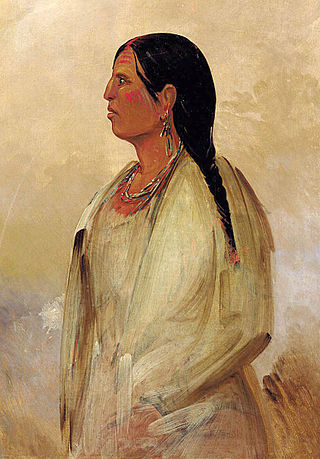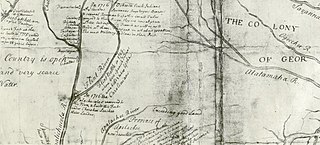Related Research Articles
Muscogee mythology is related to a Muscogee tribe who are originally from the southeastern United States, also known by their original name Mvskoke, the name they use to identify themselves today. Mvskoke is their name in traditional spelling. Modern Muscogees live primarily in Oklahoma, Alabama, Georgia, and Florida. Their language, Mvskoke, is a member of the Eastern branch of the Muskogean language family. The Seminole are close kin to the Mvskoke and speak an Eastern Muskogean language as well. The Muscogee were considered one of the Five Civilized Tribes. After the Creek War many of the Muscogee escaped to Florida to create the Seminole.

The Apalachee were an Indigenous people of the Southeastern Woodlands, specifically an Indigenous people of Florida, who lived in the Florida Panhandle until the early 18th century. They lived between the Aucilla River and Ochlockonee River, at the head of Apalachee Bay, an area known as the Apalachee Province. They spoke a Muskogean language called Apalachee, which is now extinct.

Indigenous peoples of the Southeastern Woodlands, Southeastern cultures, or Southeast Indians are an ethnographic classification for Native Americans who have traditionally inhabited the area now part of the Southeastern United States and the northeastern border of Mexico, that share common cultural traits. This classification is a part of the Eastern Woodlands. The concept of a southeastern cultural region was developed by anthropologists, beginning with Otis Mason and Franz Boas in 1887. The boundaries of the region are defined more by shared cultural traits than by geographic distinctions. Because the cultures gradually instead of abruptly shift into Plains, Prairie, or Northeastern Woodlands cultures, scholars do not always agree on the exact limits of the Southeastern Woodland culture region. Shawnee, Powhatan, Waco, Tawakoni, Tonkawa, Karankawa, Quapaw, and Mosopelea are usually seen as marginally southeastern and their traditional lands represent the borders of the cultural region.
The Yamasees were a multiethnic confederation of Native Americans who lived in the coastal region of present-day northern coastal Georgia near the Savannah River and later in northeastern Florida. The Yamasees engaged in revolts and wars with other native groups and Europeans living in North America, specifically from Florida to North Carolina.
Hitchiti was a tribal town in what is now the Southeast United States. It was one of several towns whose people spoke the Hitchiti language. It was first known as part of the Apalachicola Province, an association of tribal towns along the Chattahoochee River. Shortly after 1690, the towns of Apalachicola Province moved to the central part of present-day Georgia, with Hitchiti joining most of those towns along Ochese Creek. In 1715, most of the towns on Ochese Creek, including Hitchiti, moved back to the Chattahoochee River, where the town remained until its people were forced to move to Indian Territory as part of the Trail of Tears.
Guale was a historic Native American chiefdom of Mississippian culture peoples located along the coast of present-day Georgia and the Sea Islands. Spanish Florida established its Roman Catholic missionary system in the chiefdom in the late 16th century.

Beginning in the second half of the 16th century, the Kingdom of Spain established a number of missions throughout La Florida in order to convert the Native Americans to Roman Catholicism, to facilitate control of the area, and to obstruct regional colonization by other Protestants, particularly, those from England and France. Spanish Florida originally included much of what is now the Southeastern United States, although Spain never exercised long-term effective control over more than the northern part of what is now the State of Florida from present-day St. Augustine to the area around Tallahassee, southeastern Georgia, and some coastal settlements, such as Pensacola, Florida. A few short-lived missions were established in other locations, including Mission Santa Elena in present-day South Carolina, around the Florida peninsula, and in the interior of Georgia and Alabama.
The Chisca were a tribe of Native Americans living in present-day eastern Tennessee and southwestern Virginia in the 16th century. Their descendants, the Yuchi lived in present-day Alabama, Georgia, and Florida in the 17th, 18th, and early 19th centuries, and were removed to Indian Territory in the 1830s.

The Spanish missions in Georgia comprised a series of religious outposts established by Spanish Catholics in order to spread the Christian doctrine among the Guale and various Timucua peoples in southeastern Georgia.
Apalachicola Province was a group or association of towns located along the lower part of the Chattahoochee River in present-day Alabama and Georgia. The Spanish so called it because they perceived it as a political entity under the leadership of the town of Apalacicola. It is believed that before the 17th century, the residents of all the Apalachicola towns spoke the Hitchiti language, although other towns whose people spoke the Muscogee language relocated among the Apalachicolas along the Chattahoochee River in the middle- to later- 17th century. All of the Apalachicola towns moved to central Georgia at the end of the 17th century, where the English called them "Ochese Creek Indians". They moved back to the Chattahoochee River after 1715, with the English then calling them "Lower Creeks", while the Spanish called them "Ochese".
Henry Woodward, was a Barbados-born merchant and colonist who was one of the first white settlers in the Carolinas. He established relationships with many Native American Tribes in the American southeast. He initiated trade, primarily in deerskins and slaves, with many Indian towns and tribes.

The Chacatos were a Native American people who lived in the upper Apalachicola River and Chipola River basins in what is now Florida in the 17th century. The Spanish established two missions in Chacato villages in 1674. As a result of attempts by the missionaries to impose full observance of Christian rites and morals on the newly converted Chacatos, many of them rebelled, trying to murder one of the missionaries. Many of the rebels fled to Tawasa, while others joined the Chiscas, who had become openly hostile to the Spanish. Other Chacatos moved to missions in or closer to Apalachee Province, abandoning their villages west of the Apalachicola River.
Ahaya was the first recorded chief of the Alachua band of the Seminole tribe. European-Americans called him Cowkeeper, as he held a very large herd of cattle. Ahaya was the chief of a town of Oconee people near the Chattahoochee River. Around 1750 he led his people into Florida where they settled around Payne's Prairie, part of what the Spanish called tierras de la chua, "Alachua Country" in English. The Spanish called Ahaya's people cimarones, which eventually became "Seminoles" in English. Ahaya fought the Spanish, and sought friendship with the British, allying with them after Spain ceded Florida to Great Britain in 1763, and staying loyal to them through the American Revolutionary War. He died shortly after Britain returned Florida to Spain in 1783.
The Indigenous peoples of Florida lived in what is now known as Florida for more than 12,000 years before the time of first contact with Europeans. However, the indigenous Floridians living east of the Apalachicola River had largely died out by the early 18th century. Some Apalachees migrated to Louisiana, where their descendants now live; some were taken to Cuba and Mexico by the Spanish in the 18th century, and a few may have been absorbed into the Seminole and Miccosukee tribes.

The Battle of Flint River, also called the Spanish-Indian Battle (1702) or the Battle of the Blankets , was a failed attack by Spanish and Apalachee Indian forces against Creek Indians in October 1702 in what is now the state of Georgia. The battle was a major element in ongoing frontier hostilities between English colonists from the Province of Carolina and Spanish Florida, and it was a prelude to more organized military actions of Queen Anne's War.
Damián de Vega Castro y Pardo was the governor of the Spanish province of La Florida from November 26, 1638 to April 10, 1645.
Pedro de Olivera y Fullana, was the governor and captain general of Spanish Florida from July 13 to October 30, 1716. He died at the provincial capital, St. Augustine, just over three months into his term of office.
Apalachicola was a tribal town in the Apalachicola Province in the 17th century, located on the lower part of the Chattahoochee River in what is now Alabama and Georgia. The residents of the town spoke the Hitchiti language. The town of Apalachicola moved to the Savannah River in the early 1690s, when the other towns in Apalachicola Province moved to central Georgia, primarily to sites along the Ocmulgee River. In 1715, Apalachicola moved back to the Chattahoochee River along with the towns that had been on the Ocmulgee River, with the English then calling them "Lower Creeks", while the Spanish called them "Ochese". The town of Apalachicola continued as part of the Lower Towns through the 18th century.
The Amacanos were a native American people who lived in the vicinity of Apalachee Province in Spanish Florida during the 17th century. They are believed to have been related to, and spoken the same language as, the Chacato, Chine, Pacara and Pensacola peoples. The Amacano were served, together with other peoples, by a series of Spanish missions during the last quarter of the 17th century.
The Chine people were a group of Native American people living in Apalachee Province in Spanish Florida from the early 1670s until the end of the 17th century. They are believed to have spoken the same language as the Chatot, Amacano, Pacara, and Pensacola people, and have been described as a band of the Chatot people. They were served by a series of Spanish missions in the last quarter of the 17th century.
References
- ↑ Hann 2006, pp. 8, 10.
- ↑ Gatschet 1884, p. 144.
- ↑ Knight & Mistovich 1984, pp. 111–112; Worth 2000, p. 277.
- ↑ Worth 2000, pp. 267–269, 271–273; Goddard 2005, p. 36.
- ↑ Boyd 1949, pp. 25–26; Hahn 2004, p. 29; Hann 2006, pp. 10–11, 45, 90; Hann 1990, p. 479; Goddard 2005, p. 36.
- ↑ Hahn 2004, p. 30; Hann 1990, p. 495; Hann 2006, pp. 88 (map), 93, 96–97.
- ↑ Hann 1990, p. 495; Hann 2006, pp. 59–62, 95–97.
- ↑ Hahn 2004, p. 34; Hann 2006, pp. 88 (map), 95, 97.
- ↑ Bolton 1964, p. 138; Boyd 1937, pp. 4–6; Forster 2022, Appendix C; Hahn 2004, p. 35, 51; Hann 1990, pp. 494–495, 510–511; Hann 2006, p. 88 (map), 100.
- ↑ Hahn 2004, pp. 49–51, 54; Hann 1990, pp. 510–511; Worth 2000, pp. 280–282.
- ↑ Boyd 1949, pp. 4–7; Hahn 2004, p. 90.
- ↑ Boyd 1949, pp. 19–22, 25–26; Knight & Mistovich 1984, p. 81.
- ↑ Boyd 1952, pp. 113–114, 134; Covington 1972, p. 384.
- ↑ Hann 2006, p. 93; Knight & Mistovich 1984, pp. 81–82, 111–112; Worth 2000, p. 277.